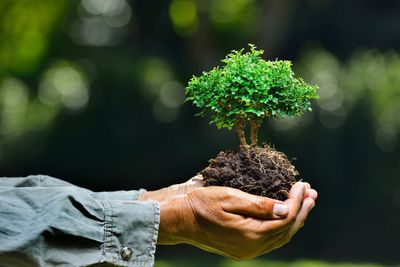Bonsai Soil Requirements
Soil for bonsai has to meet three different criteria: It must allow for good water retention, drainage, and aeration. The soil must be able to hold and retain sufficient moisture yet water must be able to drain immediately from the pot. The ingredients for bonsai soil must be large enough to allow for air pockets to provide oxygen to the roots and to microbacteria.
What is Bonsai Soil Made Up Of?
The common ingredients in bonsai soil are akadama, pumice, lava rock, organic potting compost, and fine gravel. Ideal bonsai soil should be pH neutral, neither acidic nor basic. A pH between 6.5 and 7.5 is ideal.
Bonsai Soil Information
Akadama is a hard-baked Japanese clay that is available online. After about two years, akadama begins to break down, which reduces aeration. This means that repotting is needed or that akadama should be used in a mix with well-draining soil components. Akadama is a bit costly, so it is sometimes substituted with fired/baked clays that are more readily available at garden centers. Even kitty litter is sometimes used in lieu of akadama. Pumice is a soft volcanic product that absorbs both water and nutrients well. Lava rock helps retain water and adds structure to the bonsai soil. Organic potting compost may be peat moss, perlite, and sand. It doesn’t aerate or drain well and retains water but as a part of the soil mix it works. One of the more common options for organic compost for use in bonsai soil is pine bark because it breaks down slower than other types of compost; rapid breakdown can impede drainage. Fine gravel or grit help with drainage and aeration and is used as the bottom layer of a bonsai pot. Some people do not use this anymore and just use a mix of akadama, pumice, and lava rock.
How to Make Bonsai Soil
The exact mix of bonsai soil is dependent on what type of tree species is being used. That said, here are guidelines for two types of soil, one for deciduous trees and one for conifers.
For deciduous bonsai trees use 50% akadama, 25% pumice, and 25% lava rock.
For conifers use 33% akadama, 33% pumice, and 33% lava rock.
Depending upon your region’s conditions, you may need to amend the soil differently. That is, if you do not check on the trees a couple of times a day, add more akadame or organic potting compost to the mix to increase water retention. If the climate in your area is wet, add more lava rock or grit to improve drainage. Sift the dust from the akadama to improve aeration and drainage of the soil. Add the pumice to the mix. Then add the lava rock. If the lava rock is dusty, sift it as well prior to adding it to the mix. If water absorption is important, add organic soil into the mix. This isn’t always necessary, however. Usually, the above mix of akadama, pumice, and lava rock is sufficient. Sometimes, getting soil for bonsai just right takes a little trial and error. Start with the basic recipe and keep a close eye on the tree. If drainage or aeration needs improvement, re-amend the soil.
